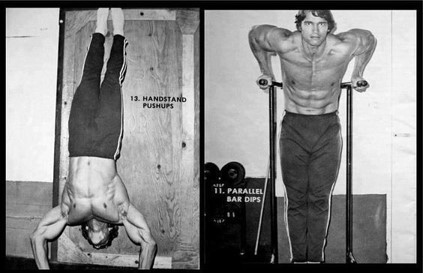I think I first read this book around 2014-2015. It’s a solid read and chock full of great information on how to get into great shape using just your own body weight.
The authors of the book examine body weight training through the lens of America’s penitentiary system. For generations guys on the inside got big and strong using just their own body weight. The book aims to share this collective knowledge with the reader and there’s lots of little tidbits you can take and apply right away (e.g. I like the Mike Tyson Squat Workout and the Royce Gracie Neck Workout covered in the book).
As I was saying, I was flipping through the book recently looking for some ideas to increase the intensity of my body weight workouts and I came across a section outlining some ideas to help making your body weight workouts more challenging.
Here are three concepts or principles the book recommends applying to your exercises to increase their difficulty:
1 Concentrate on the Negative
2. Keep Leverage in Mind
3. Reassess Your Connection to the Floor
Concentrate on the Negative
This is a simple and straightforward concept.
The negative or eccentric portion of a body weight movement is lowering portion of the exercise (e.g. lowering yourself in a push-up or pull-up etc.).
The idea of concentrating on the negative is to slow down this eccentric or lowering portion of the movement so you can focus on establishing a mind-muscle connection.
For example, if a set of 20 push-ups or 10 pull-ups is easy, try doing them with a five-second negative.
Much more difficult.
This is a fantastic way to increase the intensity of the movement as you’re increasing the time under tension (TUT) for the worked muscle groups.
If you want to take it a step further, pause and hold each rep in the bottom position.
For example, if you’re doing pull-ups you’d lower yourself down for five seconds until you reach the bottom position. Once you hit this bottom position pause for an additional few seconds before starting your next rep. The idea here is to dissipate any stored elastic energy in your tendons and ligaments, making the movement that much more challenging.
Keep Leverage in Mind
Another way to increase the difficulty of body weight training is to consider the proximity of your extremities to your core.
The principle goes like this: the greater the distance between the muscles you are targeting and what you are trying to lift, the less mechanical advantage you have.
An example may help:
Let’s say you are deadlifting with a barbell.
The further the barbell drifts away from the midline of your body, the harder and heavier it will be to get the weight off the ground.
This is one reason why trap bar dead lifts are easier than barbell deadlifts as your body weight is basically right over top of the bar.
When you apply this principle to body weight movements, you’ll notice that lunging with your arms above your head is harder than keeping them by your side.
With push-ups, you can adjust your hand placement and have them higher in front of your head to increase the difficulty of the exercise. Same with sit ups, extend your arms above your head to make the movement more difficult.
Reassess Your Connection to the Floor
Most will understand this principle intuitively.
What’s harder – a regular push-up or a push-up done with your feet elevated?
Answer: a push-up done with your feet elevated.
The idea behind this principle is to elevate your front or back to increase the difficultly of a movement.
If a movement becomes too easy try to reduce the surface area that you have in contact with the floor.
For example, body weight squats can become easy over time.
Try pistols (one-legged squats) instead.
With push ups you can try to work your way up to one arm push-ups and eventually to handstand push-ups.
There are lots of tweaks you can make like this to up the ante of body weight movements.
The book covers several other techniques to increase the intensity of body weight movements – including the concept of partial reps where you break down a movement into smaller increments. For example, with a prison squat you do three reps in the bottom position, three reps in the middle position, then three reps full range but only count that as one rep.
There are countless examples and ideas like this littered throughout Jailhouse Strong.
In fact, there’s a whole section devoted on neck training that’s got me fired up to build a thick, powerful neck (a body part that I have admittedly neglected for many years).
Final Word
If there’s one lesson I’ve learned from Jailhouse Strong it’s this: a simple training regimen executed with gusto and consistency beats any fancy program with the latest and greatest gadgets, machines, and contraptions.
Guys on the inside have been getting huge for decades on often nothing but body weight training. I recommend grabbing a copy of Jailhouse Strong if you’re looking to reinvigorate your body weight training and take your workouts to a new level.
As always,
Here’s to staying fit and looking sharp!
This content was originally published here.









